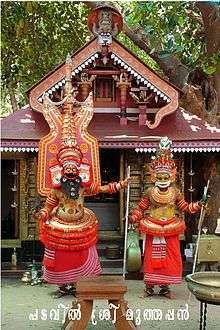Theyyam
Theyyam (Teyyam, Theyam, Theyyattam) is a popular ritual form of worship in Kerala, India, predominantly in the Kolathunadu area (consisting of present-day Kasargod, Kannur Districts, Mananthavady Taluk of Wayanad and Vadakara and Koyilandy Taluks of Kozhikode of Kerala) and also in South Canara and Kodagu of Karnataka as a living cult with several thousand-year-old traditions, rituals and customs. The performers of Theyyam belong to the lower caste community in ancient caste structure formed by Namboothiri brahmins in Kerala, and have an important position in Theyyam. The people of these districts consider Theyyam itself as a channel to a God and they thus seek blessings from Theyyam. A similar custom is followed in the Mangalore region of neighbouring Karnataka known as Bhuta Kola.


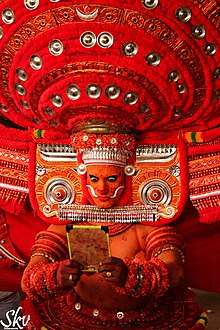
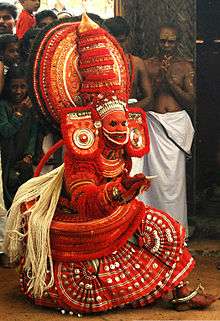
Theyyam is performed by mainly by males, except the Devakoothu theyyam. The Devakoothu is the only Theyyam ritual performed by women.[1]It is performed only on the Thekkumbad Kulom temple.[2]
History
"There can be no doubt", say Bridget and Raymond Alchin, "that a very large part of this modern folk religion is extremely ancient and contains traits which originated during the earliest periods of Neolithic, Chalcolithic settlement and expression" mainly there is no doubt, giving from fremin.[3]
There are approximately 400 types of Theyyam, including Vettakkorumakan, Vishnumoorthy Theyyam, Muchilot Bhagavathi theyyam And Sree Muthappan Theyyam.[4]
Classification of sub-cults
According to K. K. N. Kurup, it can be said that all the prominent characteristics of primitive, tribal, religious worship had widened the stream of Theyyam cult, where "even the followers of Islam are associated with the cult in its functional aspect"[5] and made it a deep-rooted folk religion of millions. For instance, the cult of Bhagawathi, the Mother Goddesses had and still has an important place in Theyyam. Besides this, the practices like spirit-worship, ancestor-worship, hero-worship, masathi-worship, tree-worship, animal worship, serpent-worship, the worship of the Goddesses of disease and the worship of Gramadevata (Village-Deity) are included in the mainstream of the Theyyam cult. Along with these Gods and Goddesses there exist innumerable folk Gods and Goddesses. Most of these Goddesses are known as Bhagavathy (the Mother-Goddess that is the Divine and United form of the three principal Goddesses namely, Brahmani (Saraswati), Vaishnavi (Lakshmi), and Shivani (Parvati).
Different branches of mainstream Hindu religion such as Shaktism, Vaishnavism and Shaivism now dominate the cult of Theyyam. However, the forms of propitiation and other rituals are continuations of a very ancient tradition. In several cult-centres, blood offering is seen, despite being forbidden in sattvic Hinduism, Jainism and Buddhism. In such centres, separate places outside the precincts of the shrine are selected for blood offering and for the preparation of the traditional Kalam (Square made for this sacrifice occasion) known as Vadakkan Vathil. The Theyyam deities propitiated through cock-sacrifice will not enter such shrines. This religious cockfight over blood sacrifice, which does also include the cockfight as a blood sacrifice, is a prime example of "cultural synthesis of 'little' and 'great' cultures".[6]
On account of the supposedly late revival of the Vaishnavism movement in Kerala, it does not have a deep impact on the Theyyam cult. Only a few deities are available under this category. Two major Theyyam deities of Vaishnavism are Vishnumoorthi and Daivathar. Vaishnavism was very popular in the Tuluva region in the 13th century when it came under the rule of Vishnuvardhana of the Hoysala dynasty. He was a great champion of Vaishnavism. Most probably he was initially deified as Vishnumoorthi and incorporated into the Bhoota cult of the Tuluvas and then further incorporated as a prominent folk deity into the Theyyam cult as well. To some, the legend of Vishnumoorthi is symbolizes the God's migration from Mangalore to Kolathunadu.
All other categories of Theyyam deities can be classified under Shaivism or Shaktism. Even spirits, ancestors, heroes, and animals are deified and included in those categories. Briefly, Theyyam provides a good example for the religious evolution of, and the subsequent different stages in modern Hinduism, with the overall understanding that within Hindu syncretism lay propitiation as ancient practices and rituals of ancient worship intended for the blessings of the supernatural not unlike, "in Indus Valley and other ancient civilizations, mother goddess had been invoked for fertility and prosperity".[7]
Patronage
Out of devotion, ruling clans established their own shrines and Kavus for Theyyam deities where non-sattvic rituals and customs are observed. The Goddesses like Rakteshwari, Chamundi, Someshwari, Kurathi, and the Gods like Vishnumoorthi are propitiated in these household shrines. There, the Theyyam dancers appear during the annual festivals of Gods and Goddesses. The rituals in such shrines are different from those of the Brahmanical temples. The impact of this cultural fusion could be traced to the social organisation based on the caste system and in the agrarian relations. The inviting of Brahmin Thanthri to consecrate the idols of Kavu is a recent development.[8]
Performance

The dance or invocation is generally performed in front of the village shrine. It is also performed in the houses as ancestor-worship with elaborate rites and rituals.
There is no stage or curtain or other such arrangements for the performance. The devotees would be standing or some of them would be sitting on a sacred tree in front of the shrine. In short, it is an open theatre. A performance of a particular deity according to its significance and hierarchy in the shrine continues for 12 to 24 hours with intervals. The chief dancer who propitiates the central deity of the shrine has to reside in the rituals. Further, after the sun sets, this particular dancer would not eat anything for the remainder of that day. His make-up is done by specialists and other dancers. The first part of the performance is usually known as Vellattam or Thottam. It is performed without proper make-up or any decorative costume. Only a small, red headdress is worn on this occasion.
The dancer along with the drummers recites the particular ritual song, which describes the myths and legends, of the deity of the shrine or the folk deity to be propitiated. This is accompanied by the playing of folk musical instruments. After finishing this primary ritualistic part of the invocation, the dancer returns to the green room. Again after a short interval he appears with proper make-up and costumes. There are different patterns of face-painting. Some of these patterns are called vairadelam, kattaram, kozhipuspam, kottumpurikam, and prakkezhuthu. Mostly primary and secondary colours are applied with contrast for face painting. It helps in effecting certain stylization in the dances. Then the dancer comes in front of the shrine and gradually "metamorphoses" into the particular deity of the shrine. He, after observation of certain rituals places the head-dress on his head and starts dancing. In the background, folk musical instruments like chenda, tudi, kuzhal and veekni are played in a certain rhythm. All the dancers take a shield and kadthala (sword) in their hands as continuation of the cult of weapons. Then the dancer circumambulates the shrine, runs in the courtyard and continues dancing there. The Theyyam dance has different steps known as Kalaasams. Each Kalasam is repeated systematically from the first to the eighth step of footwork. A performance is a combination of playing of musical instruments, vocal recitations, dance, and peculiar makeup (usually predominantly orange) and costumes. The Kathivanoor Veeran Theyyam is one of the famous theyyam in Kerala[9]
Types of Theyyams
There are about 456 types of Theyyam(theyyakkolams), among which 112 are famous.Some of the famous Theyyams are:[10]
Vishnumoorthi
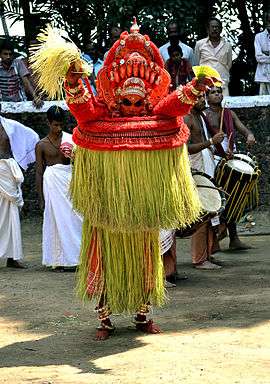
It is the most popular Vaishnava Theyyam.This theyyam narrates and performs the story of Palanthai Kannan,who was a great devotee of Lord Vishnu.[11]
Sree Muthappan Theyyam
Muthappan theyyam consists of two divine figures is considered as the personification of two divine figures— the Thiruvappana or Valiya Muttapan(Vishnu) and the Vellatom or Cheriya Muttapan(Shiva).[12]Muthappan Theyyam is different from other theyyams as it is performed all around the year. Muthappan Anthithira is another theyyam dedicated to Muthapan. The uniqueness of it is that it is performed only once in all the Muthapan temples.[13]
Padikutti Amma
The Padikuttiyamma is believed to be the mother of Muthapan. The Padikutti Amma Theyyam is performed in the Palaprath Temple in Kodallur near Parassini Kadavu in the Meenam(a Malayalam month).[14]
Gulikan
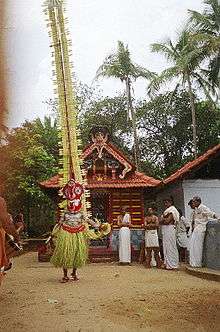
Gulikan represents Yama,the Hindu God of death, called Yama. The Benkanakavu (Venganakavu) in Nileshwar is the most famous temple dedicated to Gulikan.[15]
Padamadakki Bhagavathy
It is performed in the Koroth Temple. The legend behind the Padamadakki Bhagavathy theyyam is that the Nileswarr Raja prayed to the goddess for help from the invading army from Karnataka and Devi sent Padamadakki Bhagavathy for help. Upon seeing the Padamadakki Bhagavathy,the attacking army became unconscious and thus the war was averted.[16]
Kathivanur Veeran
The Kathivanur Veeran theyyam is performed in the memory of the great warrior Mandhappan.[17]
Manakkott Amma
Manakkott Amma Theyyam is performed in the Vairajathan Temple in Nileshwar. The Manakott was a woman born in a Nair family. She opposed the caste system that existed at that time. When she breaker a caste rule, she was killed by the head of the family. She was pregnant at that time. Her murder caused a lot of problems in their family and was finally destroyed. Later she emerged as a Goddess.[18]
Kuttichathan
Kuttichathan is a famous theyyam.[19]
Recent development
Theyyam museum is planned to be built at Chanthappura in Kalyassery of Kannur district in 2019.[20]
Gallery
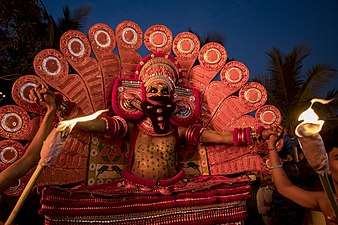 Pullivettaykkorumakan
Pullivettaykkorumakan Bhagavathi
Bhagavathi Puliyoor kaali
Puliyoor kaali
 make-up
make-up Kandanaarkelan Theyyam
Kandanaarkelan Theyyam
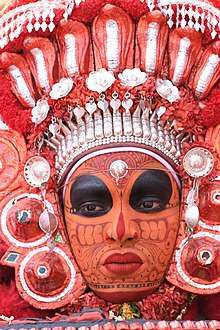 Vishnumoorthi
Vishnumoorthi
See also
- Temples of Kerala
- Uttama Villain
- Padayani
- Neeliyar Bhagavathi
- Thirayattam
References
- https://english.mathrubhumi.com/mobile/videos/news/news-in-videos/devakoothu-the-lone-woman-theyyam-in-north-malabar-1.3468731
- http://m.timesofindia.com/articleshow/17735370.cms
- Alchin, Bridget; Alchin, Raymond (1968). The Birth of Indian Civilization. p. 3039..
- https://m.timesofindia.com/articleshow/17735370.cms
- Kurup, K. K. N. (1990). "Teyyam - A Vanishing Ritual Dance of Kerala". In Kusuman, K. K. (ed.). A Panorama of Indian Culture: Professor A. Sreedhara Menon Felicitation Volume. Mittal Publications. p. 129.
- Kurup, K. K. N. (1990). "Theyyam - A Vanishing Ritual Dance of Kerala". In Kusuman, K. K. (ed.). A Panorama of Indian Culture: Professor A. Sreedhara Menon Felicitation Volume. Mittal Publications. p. 127–128.
- Kurup, K. K. N. (1990). "Teyyam - A Vanishing Ritual Dance of Kerala". In Kusuman, K. K. (ed.). A Panorama of Indian Culture: Professor A. Sreedhara Menon Felicitation Volume. Mittal Publications. p. 130.
- Kurup, K. K. N. (1990). "Teyyam - A Vanishing Ritual Dance of Kerala". In Kusuman, K. K. (ed.). A Panorama of Indian Culture: Professor A. Sreedhara Menon Felicitation Volume. Mittal Publications. pp. 128–129.
- "For ethereal nights, walk with the Theyyams of Kannur".
- "Various forms of Theyyams". Retrieved 2 March 2019.
- "Various forms of Theyyams". Retrieved 2 March 2019.
- "Muthappan devotees gather for festivities". City: Thiruvananthapuram. Manorama News. TNN. 9 January 2019. Retrieved 2 March 2020.
- "Various forms of Theyyams". Retrieved 2 March 2019.
- "Various forms of Theyyams". Retrieved 2 March 2019.
- "Various forms of Theyyams". Retrieved 2 March 2019.
- "Various forms of Theyyams". Retrieved 2 March 2019.
- "Various forms of Theyyams". Retrieved 2 March 2019.
- "Various forms of Theyyams". Retrieved 2 March 2019.
- "Various forms of Theyyams". Retrieved 2 March 2019.
- "Kannur: Sophisticated Theyyam Museum coming up". Retrieved 4 March 2020.
Further reading
- Killius, Rolf (2006). Ritual Music and Hindu Rituals of Kerala. New Delhi: BR Rhythms. ISBN 978-81-88827-07-7..
- Kurup, KKN (March 1986). Theyyam – A Ritual Dance of Kerala. Thiruvananthapuram: Director of Public Relations, Government of Kerala..
- Daugherty, Diane (Autumn 2000). "Fifty Years on: Arts Funding in Kerala Today". Asian Theatre Journal. 17 (2). JSTOR 1124491.
- Freeman, J. R. (May 1999). "Gods, Groves and the Culture of Nature in Kerala". Modern Asian Studies. 33 (2): 257–302. doi:10.1017/s0026749x99003261. JSTOR 313169.
- Nambiar, Balan (1981). "Gods and Ghosts – Theyyam and Bhuta rituals". Doshi, Saryu (ed) The performing Arts, Marg Volume 34, Issues 3–4, Bombay, 1981, pp 62–73
- Ashley, Wayne (June 1979). "The Theyyam Kettu of Northern Kerala". The Drama Review: TDR. 23 (2): 99–112. JSTOR 1145219.
- Kerala Sangeetha Nataka Akademi (ed) THEYYAM (a symposium), Lumiere Printing Works, Trichur, 1978
- "Ethnographic collection". Indira Gandhi National Centre for the Arts. IGNCA, Delhi. Retrieved 10 October 2014. New Delhi has a collection of 1800 slides with research notes by Balan Nambiar
External links
| Wikimedia Commons has media related to Theyyam. |
- Theyyakkolam: A complete theyyam website | Theyyam in Malabar
- Theyyam calendar, including images.
- A Journey through theyyams on Youtube
- A Complete Guide to Theyyam
